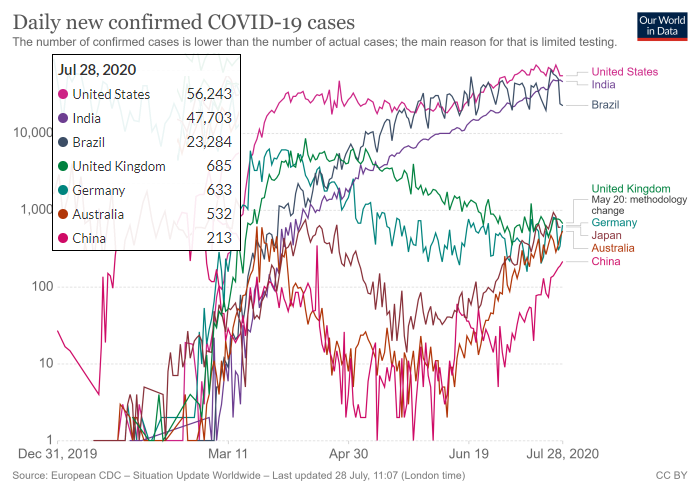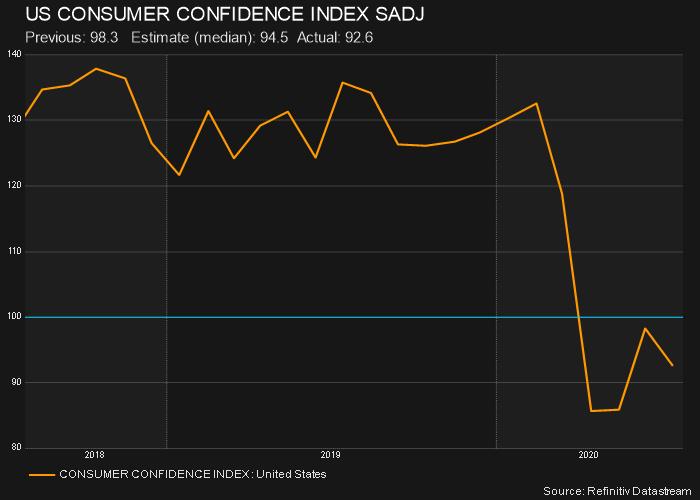A snapshot of overnight moves and a look to the upcoming Australasian session for 29 July.
Market Moves
Wrap
US markets were down again Tuesday, as weak earnings, a lack of good news on further fiscal stimulus, and continued stubbornly high daily infections of covid-19 left investors (and stock prices) deflated.
The tech-heavy NASDAQ led the falls, closing 1.27% lower. The blue chip-laden Dow Jones Industrial Index fell 0.77%, whilst the benchmark S&P500 lost 0.65%.
Senate Republicans’ confirmed the details of their $1 trillion coronavirus relief package late Monday, and yesterday commenced negotiations with Democrats over another fiscal stimulus bill. As these negotiations play out, markets will consider that anything less than $1 trillion is a disappointment.
On the vaccine front, hopefuls Moderna, Pfizer, and BioNTech each started late-stage trials of their treatment candidates. Daily confirmed cases of covid-19 in the US rose slightly to 56k per day.

The Federal Reserve began its two-day meeting Tuesday. Chairman Jerome Powell will speak tonight, and is likely to confirm the willingness of the Fed to take further action to support the economy as required.
On a positive note, yesterday the Fed announced that it would extend a number of emergency loan programs that had been set to expire on Sept. 30 to the end of 2020.
Metals prices on the LME were mixed, but saw reasonable gains in Aluminium 0.96%, Copper 0.55%, and Zinc 1.40%. Nickel was the worst performer, down 0.71%. Copper was down 0.24% in New York.
Iron Ore prices were slightly higher on the Chinese Dalian Exchange, up 0.18%, and were 0.25% higher in the Singapore-based $US price.
Looking at precious metals, Spot Gold had a wild ride during Tuesday's trade. It topped out at just over US$1980/oz, before plunging as low as US$1907/oz and then closing at US$1958/oz. Silver prices were just as crazy, swinging wildly before closing down 2.62% on the session.
Helping precious metals, the yield on the 10-year US Treasury note fell 2.8 basis points to 0.581%. This is its lowest level since April 21. Given that gold has a zero yield, as market yields fall, so too does the opportunity cost of holding gold.
Looking at energy commodities, West Texas Crude fell 1.46% to US$41.03/barrel, Brent fell 0.66%, and Natural managed a 3.98% gain.
In currency moves, Australian Dollar improved 0.06% as the US Dollar Index rose 0.03%.
So with a generally risk off move in asset prices Tuesday, where did the ASX200 Share Price Index end up this morning? Well, it had a tough session, closing at 5960 compared to an overnight session high of 6009 and a low of 5957.
That's a 60 point discount to yesterday's ASX 200 close of 6020, and predictive of a flat 0.7-1.0% fall at the open for the S&P ASX200.
AU Companies
In early broker moves, Citigroup has downgraded GUD Holdings (GUD) from buy to neutral, and lowered its price target for the stock from $12.85 to $12.75. Jefferies has upgraded property stocks GPT and CQR to buy.
This morning, the following companies have updated the market: Ecofibre Limited (EOF), IGO Limited (IGO), 99 Technology Limited (NNT), Nuchev Limited (NUC), Readcloud Limited (RCL), and St Barbara Limited (SBM).
Macro Economy
Today, we'll see data on Australian inflation with the release of the June quarter consumer price index (CPI) at 9.30am Sydney time. Markets are expecting prices to have fallen by as much as 2% over the quarter as business cut prices in response to lower consumer spending.
Below is a summary of the key macroeconomic data releases from the past 24 hours.
USA

The Conference Board’s consumer-confidence index fell to 92.6 in July from June's 98.3. This was below economists' expectation for a reading of 94.5.
The index measures how consumers feel about the economy right now (this actually improved to 94.2 from 86.7), and into the future (disturbingly, this fell to a four-month low of 91.5 from 106.1 in June).
The data reflects a tough month for consumers in July as they digested rising virus cases, weaker labour market conditions, and a stalling in Washington with respect to further stimulus measures. Together, these factors translated into consumers becoming more cautious about their prospects going forward.